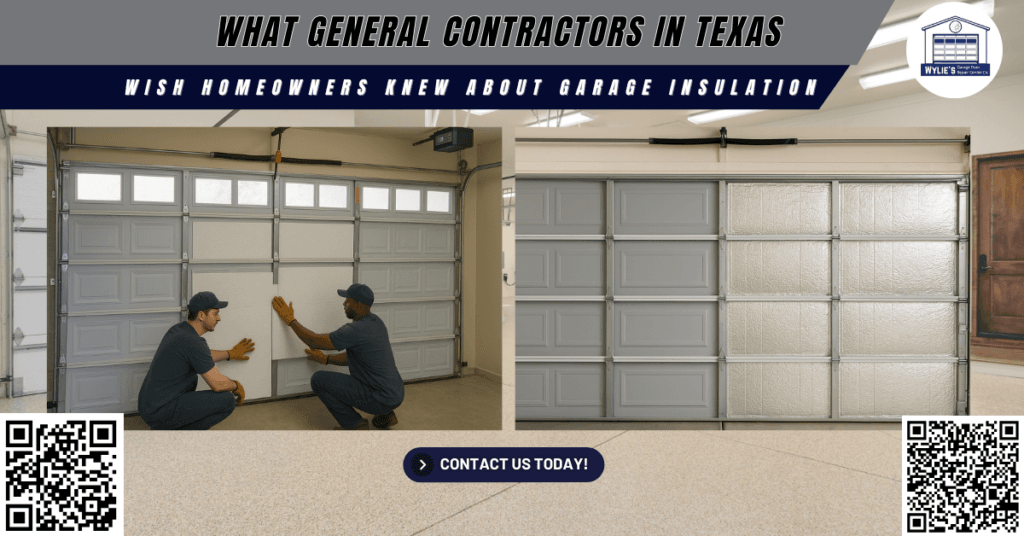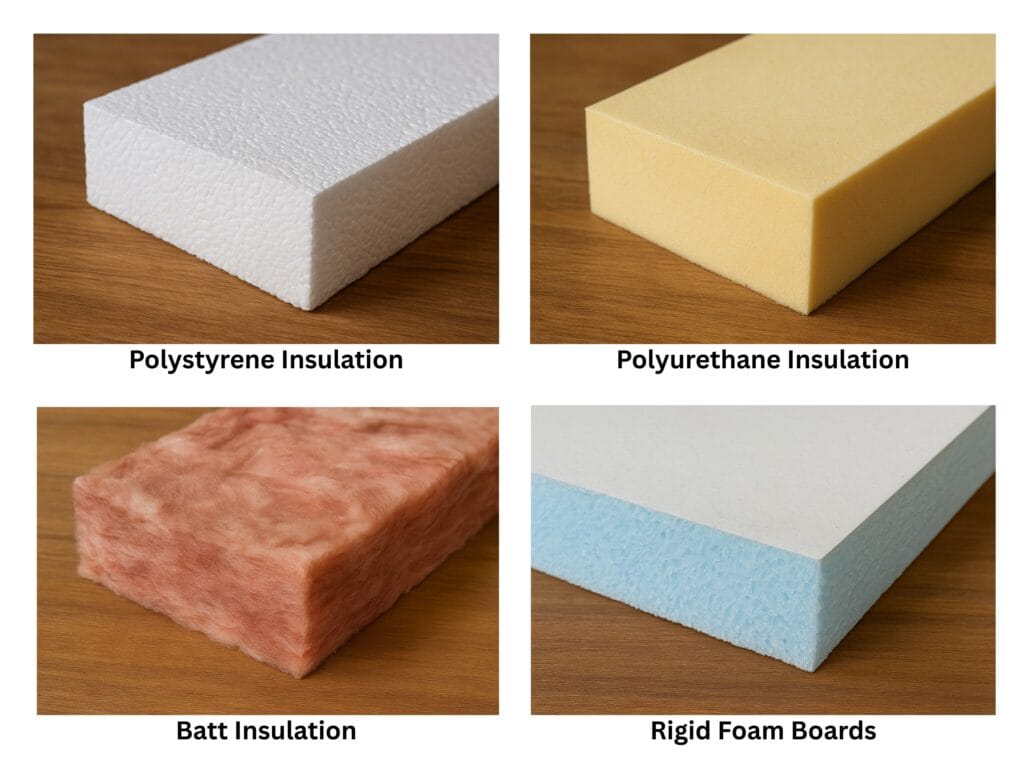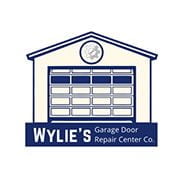What General Contractors in Texas Wish Homeowners Knew About Garage Insulation

It started with a common complaint from a homeowner in Wylie, TX: “My garage is hotter than the sidewalk in August.” He had recently converted the garage space into a home gym, but couldn’t use it past noon due to unbearable heat. After a thorough inspection, our team at Wylie’s Garage Door Repair Center Co. discovered the garage was fitted with a non-insulated door, no wall or ceiling insulation, and weather seals that had completely worn out. This situation is more common than you’d think, especially in Texas, where garages are often built with minimal consideration for thermal protection. In cases like these, installing insulated garage doors is one of the most effective ways to reduce heat transfer, regulate temperature, and make the garage space usable year-round.
According to the U.S. Department of Energy, insulating your garage can reduce overall energy loss in a home by up to 20%, especially when the garage is attached to temperature-sensitive areas like bedrooms or kitchens. Yet many homeowners remain unaware of the true impact of insulation on energy efficiency, energy bills, indoor comfort, and garage door longevity.
As a trusted provider of garage door repair, installation, and maintenance in Wylie, TX, our team at Wylie’s Garage Door Repair Center Co. has seen firsthand how proper insulation transforms garage spaces. Whether you’re protecting your car, storing valuable materials, or converting your garage into usable living space, insulation is a key investment in performance, comfort, and efficiency. Let’s dive into what general contractors in Texas wish you knew about garage insulation and how it can make a long-term difference for your home.
Why Garage Insulation Matters in Texas
In Texas, where summers are scorching and winters can be surprisingly chilly, garage insulation serves as a critical thermal barrier. Many garage doors, especially older or budget-friendly models, lack any form of insulation, making them highly susceptible to thermal transfer. This means outside heat penetrates your garage in summer, and warmth escapes in winter.

This impacts more than just comfort. If your garage shares a wall with your home, poor insulation can drive up energy bills, overwork your HVAC system, and create temperature imbalances in nearby rooms. For garages with a garage door opener or an integrated logic board, extreme heat or cold can cause malfunction, system failure, or reduce the lifespan of electronics and mechanical parts.
Insulating your garage ensures a more energy-efficient space, improved temperature regulation, and even increased noise reduction, especially if your garage is used as a workshop or gym. It also protects your car, tools, and other sensitive items stored inside from damage due to temperature extremes.
What Areas of the Garage Should Be Insulated?
Homeowners often assume that insulating the garage door alone is enough, but true insulation requires a whole-system approach. General contractors and insulation experts alike agree that for optimal heat insulation and energy savings, several areas must be addressed:
1. Garage Door Panels
Your garage door is the single largest opening in your home. Insulated garage doors, often made with steel, aluminum, and filled with polyurethane foam or polystyrene, offer higher R-values, a measure of thermal resistance. Sectional doors are often the best candidates for thick insulation layers. Upgrading to an insulated door significantly reduces heat transfer and enhances strength.
2. Garage Walls
If your walls are unfinished, they offer almost no resistance to heat or cold. Applying batt insulation (fiberglass rolls), rigid foam boards, or spray foam insulation can drastically reduce energy loss. Choose insulation materials with a high R-value or low U-value (a measure of heat transfer) for maximum performance.
3. Garage Ceiling
Especially important if you have living space above the garage. A properly insulated ceiling prevents warm or cold air from seeping into rooms above, improving the overall efficiency of your home.
4. Weather Seals and Thresholds
Even the best insulated garage doors won’t perform well if you have drafts sneaking in through cracks. Install weather stripping, bottom seals, and insulation kits for garage doors to block unwanted air, dust, pests, and moisture. Products like foam thresholds or vinyl seals provide affordable, DIY-friendly solutions.
Common Misconceptions About Garage Insulation
“Garage insulation is too expensive.”
This is a widespread myth. While there is an initial cost, the return on investment is substantial when you factor in lower energy bills, improved garage functionality, and long-term savings on equipment repairs. Options like insulation kits, foam board panels, and door insulation kits make it affordable even for budget-conscious homeowners.
“Garages aren’t living spaces, why bother?”
While it’s true that garages weren’t traditionally used as living spaces, modern homeowners increasingly convert garages into gyms, studios, offices, or game rooms. Even if it’s just used for storage, a lack of insulation can warp materials, ruin electronics, and freeze tools or liquids.
“Insulating just the door is enough.”
While upgrading to an insulated garage door helps immensely, neglecting walls, ceilings, and air leaks limits the effectiveness of your efforts. Think of it as a comprehensive insulation system, each part contributes to the whole.
Choosing the Right Garage Door Insulation Type
When selecting an insulation type for your garage door, you’ll find a wide range of products. Each comes with its own set of pros and cons, so let’s break them down:
Polystyrene
- Comes in rigid panels
- Offers good insulation at an affordable cost
- Easy to install with a garage door insulation kit
- Moderate R-values
Polyurethane
- Denser than polystyrene
- Injected into the door cavity and expands to fill gaps
- Provides high R-values and excellent noise reduction
- Stronger structural support is ideal for steel or aluminum garage doors
- Often found in premium insulated garage doors like Amarr, Clopay, or Martin Garage Doors
Fiberglass Batt Insulation
- Great for walls and ceilings
- Affordable and easy to handle
- Must be sealed properly to prevent moisture absorption
Reflective Foil (Radiant Barriers)
- Effective for reflecting radiant heat, especially in summer
- Common in Texas for garages with high sun exposure
- Often paired with foam boards for dual-layer protection

Beyond Comfort: Key Benefits of Garage Insulation
Insulating your garage offers more than just temperature control. General contractors highlight several long-term advantages:
- Energy Efficiency: Lower U-values, higher R-values, and fewer thermal transfers mean lower energy bills.
- Noise Reduction: Prevent outdoor noise from penetrating your garage and keep loud garage sounds from reaching the home.
- Durability: Insulated doors resist warping and wear from weather extremes.
- Protecting Your Car: Stable temperatures reduce wear on batteries, paint, and fluids.
- Moisture Control: Helps prevent mold growth, rusting tools, and damaged insulation materials.
- Enhanced Home Value: A garage that’s part of your home’s livable space is a huge selling point.
How Insulation Affects the Garage Door System
Uninsulated garages cause not only discomfort but also mechanical strain. Fluctuating temperature leads to the expansion and contraction of steel, affecting garage door tracks, panels, and hinges. This constant stress can reduce the life expectancy of your garage door opener, particularly those with electronic logic boards.
In addition, non-insulated doors rattle more, creating noise during operation. This is especially noticeable with older Chamberlain or Craftsman garage doors. Upgrading to insulated doors or adding insulation with a door insulation kit helps minimize wear and creates smoother, quieter operation.
Step-by-Step Guide to Insulating Your Garage
Here’s a quick breakdown of how to approach insulating your garage:
- Assess the space – Identify exposed areas: walls, ceiling, door.
- Choose the right insulation material – Fiberglass, foam, polyurethane, etc.
- Upgrade the garage door – Install a new insulated garage door or use a garage door insulation kit.
- Seal cracks – Install weather stripping and bottom thresholds.
- Consider radiant barriers – Especially effective for Texas sun exposure.
- Maintain regularly – Inspect seals, insulation panels, and check for signs of moisture or damage.
How Can Wylie’s Garage Door Repair Center Co. Help You?
At Wylie’s Garage Door Repair Center Co., we go beyond just fixing garage doors we help homeowners in Wylie, TX, and surrounding areas optimize their garage space for energy efficiency, safety, and comfort. Our expert services include:
- Installation of Insulated Garage Doors
Choose from trusted brands like Amarr, Martin, or Clopay garage doors, with customizable materials, styles, and insulation types. - Garage Door Insulation Services
We retrofit existing doors with top-tier insulation kits, foam panels, and barriers to improve thermal protection and noise control. - Garage Door Repairs and Opener Services
From broken springs and misaligned tracks to faulty logic boards and weather seals, our technicians repair it all. - Energy Efficiency Audits
We assess your garage’s current insulation and recommend upgrades tailored to your budget, garage usage, and energy goals.
📍Visit us at: 111 E Farm to Market Rd 544, Wylie, TX 75094
📞Call now: (469) 838-5939
Don’t let another Texas summer leave your garage sweltering or your energy bills soaring. Contact us today to insulate, protect, and enhance your garage with trusted, professional care from Wylie’s Garage Door Repair Center Co. Your garage deserves better; let’s make it happen!
Frequently Asked Questions (FAQs)
1. How long does garage door insulation last?
With proper installation and minimal moisture exposure, garage door insulation can last 15–20 years or more without needing replacement.
2. Can I insulate my garage door myself, or do I need a professional?
You can use a DIY insulation kit, but hiring a professional ensures proper material selection, fit, and sealing for maximum efficiency.
3. Does garage insulation help in reducing pests?
Yes, by sealing gaps and cracks, garage insulation helps prevent insects and rodents from entering through small openings.
4. Will insulating my garage affect my home insurance?
Insulating your garage typically doesn’t change your home insurance directly, but improvements in safety and energy efficiency may qualify you for certain policy discounts. Check with your provider.
